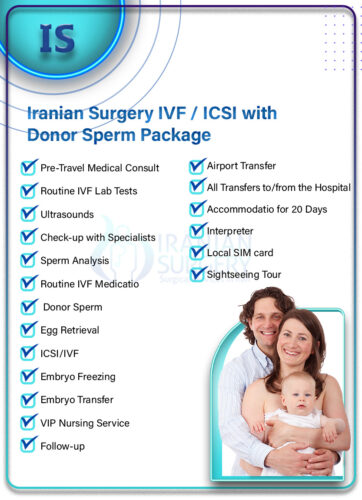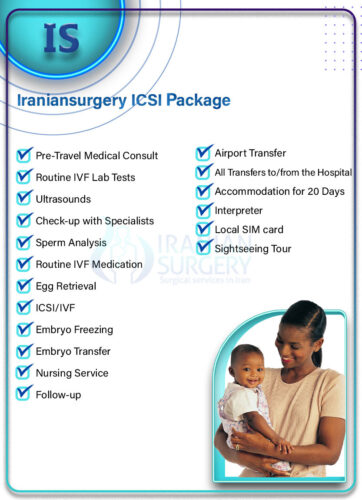Infertility Treatment In Iran
Is Iran a suitable option for infertility treatment?
The Iranian government acknowledges and promotes a range of infertility treatment options, such as IVF in keeping with its strong focus on the importance of family foundations.
Iranian infertility therapy is comparable to those of other nations such as the USA and European countries. IUI, laparoscopy, hysteroscopy, IVF, surrogacy, ICSI, PGD, PGS, egg donation, and pharmaceutical therapy are some of the popular infertility treatments offered in Iran.
Why should we choose Safemedtour?
Safemetour is a subsidiary of Iranian Surgery, a reputable and established company in the field of infertility treatment, health issues, and cosmetic surgery. The Safemetour platform specializes in helping people with infertility. This platform gives you the opportunity to realize your goal of becoming a parent by working with the most renowned and prosperous infertility clinics and qualified physicians in Iran.
What is the cost of infertility treatment in Iran?
Iran is a pioneer in the field, providing excellent and successful infertility care at very low expenses when compared to other nations. At present, the Ministry of Health has granted licenses to over 80 infertility treatment centers that operate in Iran. These centers offer a range of affordable yet great fertility treatment services to infertile couples worldwide, including IVF, ICSI, egg and sperm donation, embryo sex selection, surrogacy, and induction ovulation.
What documents do you need for infertility treatment in Iran?
Your prior medical history, your identity documents such as your passport, and any currently available test results are all you need to start your treatment in Iran. Other issues will be taken care of by the Iranian Surgery team.
Types of infertility treatment in Iran
One in six adults globally, or 17.5% of the population, suffer from infertility, demonstrating the critical need to expand access to high-quality, reasonably priced reproductive care for those who require it. There are different ways and treatments to deal with infertility. Please note that the course of treatment recommended for you if you have reproductive issues will depend on what is causing the issue.
IVF
IVF is the process of removing eggs from your ovaries and fertilizing them in a lab with sperm. The sperm and eggs may come from a donor, your spouse, or yourself.
An egg that has been fertilized is referred to as an embryo. Numerous embryos are often created. A doctor will choose the finest embryo and implant it—sometimes two—into the expectant mother’s womb.
Surrogacy
Couples who are unable to carry a pregnancy to term may choose to use a surrogate. A woman who practices surrogacy brings a fertilized embryo to term on behalf of another couple. The intended mother’s egg and the intended father’s sperm, donor eggs and sperm, or a mix of the two can be used in surrogacy.
Both Iranian and international couples may use surrogacy legally in Iran. One form of fertility therapy that is legally available to qualified couples in Iran is surrogacy.
Sperm Donation Process
Donor sperm may be a beneficial therapeutic option for those with:
- Insufficient or no sperm.
- Decreased motility of sperm.
- Sperm health is influenced by hereditary factors.
- A history of infertility efforts that failed.
The good news is that In Iran, sperm donation is always done in secret. There will be no communication at all between the donor and the recipient.
PGD
Using PGD, embryos may be identified as XX (girl) or XY (boy) before being inserted into the womb of their mother. Desired embryos are inserted for implantation into the female uterus during PGD. 99.9% precision in gender selection is possible using PGD. Genetic disorders that are inherited can be identified using PGD as well.
Egg Donation
Egg donation therapy is the process by which a single woman uses donated eggs for in vitro fertilization to conceive. The lady may become a surrogate for another couple or carry the pregnancy for her own kid, depending on the circumstances.
Microscopic Testicular Sperm Extraction (MicroTESE)
The surgical technique known as microsurgical testicular sperm extraction, or microTESE, is used to remove sperm from a man’s testes—organs that create sperm.
Egg Freezing
One way to gather, preserve, and store your unfertilized eggs is by egg freezing. Through a procedure known as vitrification, your eggs are frozen—that is, frozen in time. Until you decide whether or not you need to utilize them, they are kept securely in the laboratory.
IUI
A fertility procedure called intrauterine insemination (IUI) increases the likelihood that sperm will fertilize an egg. Couples may have better odds of getting pregnant with this medication. In perfect circumstances, just a few hundred sperm reach the egg during sexual activity.
ICSI
With the use of extremely precise micromanipulation tools, a single sperm is injected into each egg as part of an extra step in the IVF treatment cycle known as intracytoplasmic sperm injection (ICSI). ICSI is typically effective in treating severe male infertility.
Definition of infertility
When you are infertile, it means that you have not been able to conceive after a year of trying. Ovulatory problems, endometriosis, poor sperm count, and low testosterone are some of the causes of infertility. As one ages, the likelihood of infertility increases. For those who are infertile, there are several therapy choices.
Infertility in men
About 40% of cases of infertility are due to male factor infertility. It is typically caused by problems with sperm production or transport. However, male infertility can be caused by several reasons.
Varicocele
Varicoceles, or enlarged veins in the scrotum, can affect sperm function and production. Varicocele affects 15% of men, however, only approximately 35% of those men experience infertility issues. Therefore, the good news is that not all men who have varicoceles will become infertile.
Diagnosis of varicocele
Scrotal ultrasound tests might be prescribed by your urologist. Sound waves are used in ultrasound to create an image of your inside organs. Veins larger than 3 millimeters and blood flowing in the incorrect direction during the Valsalva maneuver are indicators of varicoceles on ultrasonography. The testicles’ size can also be seen on the ultrasound.
Treatment of varicocele
The severity of your varicocele determines the course of treatment. A medical professional may suggest one of the following at-home treatments for low-grade varicoceles:
- If your varicocele doesn’t affect you or interfere with your ability to conceive, you might not require treatment.
- Some activities may need to be avoided if they cause you discomfort. When working out or standing for extended periods, wearing tighter-fitting knickers (such as spandex or elastane) or a jockstrap can help reduce symptoms.
- Ibuprofen and naproxen are examples of nonsteroidal anti-inflammatory medicines (NSAIDs), that can help ease any discomfort or ache in your testicles or scrotum.
A surgical technique called a varicocelectomy is used to treat severe varicoceles that hurt or interfere with fertility. Your afflicted veins will be cut and sealed off by a surgeon who specializes in disorders of the reproductive and urinary systems. This reroutes blood flow to your scrotum’s other healthy veins.
Sperm disorders
Creating healthy sperm is one of the most prevalent reasons for infertility in men. Sperm might not be able to swim, be malformed, or be immature. You could not have enough sperm in various situations. Or maybe you won’t produce any sperm.
Diagnosis of sperm disorders
A man’s sperm disorders should always be assessed when a couple is infertile. The focus of the physical examination and history is on possible reasons, such as genitourinary diseases. Each testis should have its volume measured; a typical testis holds 20 to 25 mL. It is necessary to analyze the semen.
- Semen analysis
The guy is usually requested to abstain from ejaculation for two or three days before semen analysis. Data, however, show that unless there is an issue, everyday ejaculation does not lower a man’s sperm count. Due to variations in sperm count, testing should ideally involve at least two specimens collected at least one week apart; each specimen is collected by masturbating into a clean jar, preferably on the lab premises. If the sperm is going to be kept, the jar needs to be sterile. The male can wear a condom at home if this approach is too challenging; nevertheless, it must be chemical- and lubricant-free. It is quite rare that a sperm problem exists if the initial semen assay is normal.
- Genetic testing
Genetic testing ought to be carried out if either azoospermia or oligospermia is found. Among these tests are
- Standard karyotyping.
- Polymerase chain reaction (PCR) of tagged chromosomal locations (for the purpose of identifying Y chromosome microdeletions).
- Examination for CFTR gene mutations.
Treatment of sperm disorders
- Clomiphene
- Methods for assisted reproduction in case clomiphene is unsuccessful
Antibiotics are administered appropriately if an infection is found.
Clomiphene citrate (25 to 50 mg orally once a day administered 25 days/month for 3 to 4 months) can be tried by males whose sperm counts are between 10 and 20 million/mL and who do not have an endocrine problem. The antiestrogen clomiphene has the potential to boost sperm counts and enhance sperm production.
The most successful course of therapy is often in vitro fertilization using intracytoplasmic sperm injection, which involves injecting a single sperm into an egg if the sperm count is less than 10 million/mL or if clomiphene is not successful in males with normal sperm motility. (Sperm penetration tests are no longer frequently performed due to the widespread usage of this method.)
Retrograde ejaculation
Male infertility can arise from retrograde ejaculation (RE), which is characterized by the backward flow of semen during ejaculation. RE can be partial or total, with the consequence that the ejaculate is either completely absent (dry ejaculate) or has a reduced seminal volume.
Diagnosis of retrograde ejaculation
To identify retrograde ejaculation, your physician could:
- Inquire about the nature of your symptoms and the duration of your experience. Along with your drug regimen, your doctor may inquire about any past surgeries, malignancies, or other issues you may have had.
- Perform a physical examination, which should involve examining your penis, testicles, and rectum.
- After an orgasm, check your urine for the presence of semen. Usually, this operation takes place in the physician’s office. Your doctor will ask you to urinate, climax, and then give a sample of your urine for testing in a lab. Retrograde ejaculation occurs when there is a significant amount of sperm in your urine.
Treatment of retrograde ejaculation
For retrograde ejaculation brought on by nerve injury, medications may be helpful. Diabetes, multiple sclerosis, some surgical procedures, and other illnesses and therapies can all result in this kind of harm.
If taking medicine prevents you from ejaculating semen, you’ll probably require assisted reproductive technology, or IRT, to help you and your spouse become pregnant. Sometimes it is possible to remove sperm from the bladder, prepare them in a lab, and utilize the results to inseminate your spouse (a practice known as intrauterine insemination).
More sophisticated assisted reproductive methods are occasionally required. Once they receive therapy, many men who have retrograde ejaculation are able to conceive their partners.
Obstruction of sperm ducts
Your ejaculatory ducts (EDs) are formed by the vas deferens in each of your two testicles joining with the ducts of your seminal vesicles. Prostatic fluid is collected by the EDs as they pass past your prostate and contribute to your semen. The liquid drains down your urethra. As a result of sexual stimulation, this fluid is what transports sperm outside of your body during ejaculation.
Sperm cannot enter the ejaculate, which is the thick and white fluid that contains sperm if there is a blockage in the ejaculatory ducts. One reason for a zero sperm count is blocked ejaculatory ducts. Men with this illness have a limited likelihood of becoming biological parents if they do not receive therapy.
Diagnosis of sperm duct obstruction
If your doctor suspects ejaculatory duct obstruction (EDO), they may request any or all of the following tests:
- Analysis of semen.
- Fructose analysis of semen.
- Transverse ultrasound.
- An ultrasound of the vas deferens.
- Dye injection into the vas deferens. We refer to this as a vasogram.
Treatment of blocked sperm ducts
The following medical techniques are used to treat EDO:
- Transurethral resection of the ejaculatory ducts (TURED): This procedure involves excising any obstructions, including cysts, from the duct.
- Another less invasive treatment is seminal vesiculoscopy, which involves inserting a tiny telescope into your prostate to locate and clear the obstruction in the duct.
- Sometimes, surgeons will mix the two surgeries. In either scenario, you will need to take antibiotics to help prevent infection.
Hormonal problems in male infertility
A man’s reproductive system may be directly impacted by his hormone reserves. Fertility can be hampered, namely by low gonadotropin and testosterone levels. Male infertility brought on by hormones may result from disorders of the glands or impaired sperm production.
Diagnosis of hormonal problems in male infertility
Tests for hormones measure the amounts of testosterone and FSH (follicle-stimulating hormone) to assess the general hormonal balance and the particular stage of sperm production. If the results of the first testing show that additional hormonal testing is necessary, serum LH and prolactin levels can be measured.
Treatment of hormonal problems in male infertility
The endocrine system, or a man’s hormones, can be altered by male fertility drugs in a variety of ways. By raising the amount of bioavailable testosterone and lowering the amount of estradiol, a kind of estrogen, these drugs can help you regain your fertility. The following medications are used for this purpose:
- Clomid or Clomiphene
Either Arimidex or Anastrazole
either hMG (human menopausal gonadotropin) or hCG (human chorionic gonadotropin).
Except for hCG and hMG, which are injections, the majority of these reproductive medications are taken orally.
Physical problems
Physical problems include difficulties with sexual function, such as low ejaculation volumes or difficulty ejaculating at all, decreased desire for sexual activity, or trouble sustaining an erection (erectile dysfunction) a lump, edema, or pain around the testicles.
Physical Diagnosis
Signs and physical symptoms are indicative of an underlying issue, such as a hereditary illness, hormonal imbalance, dilated veins around the testicle, or a condition that obstructs sperm flow. You may see the following symptoms and signs:
- Difficulties with sexual function, such as low ejaculation volumes or difficulty ejaculating at all, decreased desire for sexual activity, or trouble sustaining an erection (erectile dysfunction)
- A lump, edema, or pain around the testicles.
- Repeated infections of the respiratory system.
- Being unable to smell.
- Breast development that is abnormal (gynecomastia).
- Reduced body or facial hair, as well as additional indicators of chromosomal or hormonal abnormalities.
- A sperm count that is below normal (less than 15 million sperm per milliliter of semen or less than 39 million sperm overall each ejaculate).
Physical therapy
The cause of your infertility will determine how you are treated. Surgery, medication, and artificial insemination are among the treatment options.
Torsion of the testicles in male infertility
The spermatic cord that provides blood to the scrotum twists and spins within a testicle, causing torsion of the testicles. The testicle’s blood supply is cut off by the twisting, resulting in abrupt, excruciating pain and swelling.
Your fertility may be affected by testicular torsion, particularly if you put off seeking medical assistance. Although one testicle can generate enough testosterone and sperm, the quality of the sperm may suffer.
Diagnosis of testicular torsion in male infertility
Doctors frequently discover testicular torsion during a physical examination. To verify the diagnosis and monitor blood flow to the testes, ultrasound is frequently utilized. Testicle or epididymis infections are two possible causes of testicle discomfort.
Treatment of testicular torsion in male infertility
Surgery (orchiopexy) is required for testicular torsion. Your testicle will be untwisted by a surgeon during an orchiopexy, reestablishing blood flow to the region. After that, they will use sutures to fasten your testicle to the inner wall of your scrotum. This stops the recurrence of testicular torsions.
Usually, the surgeon will operate via your scrotum, but occasionally, they will need to make a little incision through your groin. Both testicles are often affected by torsion in individuals with bell clapper malformation. In this instance, the inner scrotal wall will also be stitched to your unaffected testicle by your surgeon.
Infections and diseases
Certain infections can harm or impair sperm health or production, or they might leave scars that prevent sperm from passing through. Several STDs, such as gonorrhoea or HIV, as well as inflammation of the testicles (orchitis) or epididymis (epididymitis), are among them.
Diagnosis of infections and diseases
In certain situations, a semen test is frequently used to diagnose the issue. White blood cells are detected in the test. An excess of “reactive oxygen species” (ROS) is produced by white blood cells. This may harm sperm, decreasing the likelihood that sperm will be able to fertilize an egg. For instance, testicular shrinkage and epididymal duct obstruction may result after a severe infection of the testes and epididymis. It’s not necessary for the infection to appear suddenly to cause issues.
Treatment of infections and diseases
Full-blown illnesses are frequently treated with antibiotics. However, they are not applied to milder inflammations. Every now and again, certain antibiotics might impair sperm function or production. Instead, non-steroidal anti-inflammatories like ibuprofen are frequently utilized.
Sperm deficiency
Oligospermia is another term for a low sperm count. A total lack of sperm is referred to as azoospermia. If you have less than 15 million sperm per milliliter of semen, your sperm count is deemed below normal.
Some men may have dilated testicular veins, a disease that reduces sperm motility, hormone imbalances, or genetic chromosomal abnormalities as the underlying cause of their low sperm count symptoms. Experiencing soreness, swelling, or a lump close to the testicles.
Diagnosis of sperm deficiency
One way to determine low sperm count is by a semen analysis test. Sperm count is often ascertained by microscopically inspecting semen to count the number of sperm within each square on a grid pattern. Sperm count may sometimes be determined using a computer.
Your doctor may suggest further testing to determine the reason behind your low sperm count and other potential reasons for male infertility, based on preliminary results. These may consist of:
- Scrotal ultrasound
- Hormone testing
- Post-ejaculation urinalysis
- Genetic tests
- Testicular biopsy
- Anti-sperm antibody tests
- Specialized sperm function tests
- Transrectal ultrasound
Treatment of sperm deficiency
Human chorionic gonadotropin may be provided to men with low testosterone levels to raise sperm production and regulate FSH and LH levels. For up to six months, this medicine is injected three times a week.
Artificial insemination, or IUI, is another name for assisted reproduction. Your doctor could suggest it. This is usually advised for males who have low sperm motility, movement, or low sperm concentration, which is a decreased quantity of sperm. In cases when the sperm count is normal and the cause of infertility cannot be identified, it could also be advised.
Abnormal sperm morphology (teratospermia)
The creation of sperm with aberrant morphology that frequently has functional deficiencies is known as teratospermia. Some toxicants can cause this lesion after exposure. Compounds may directly affect sperm to change their cytoarchitecture and/or function.
Diagnosis of abnormal sperm morphology (teratospermia)
The most prevalent cause of male infertility is teratozoospermia, which occurs when aberrant sperm have trouble fertilizing an egg. The most common method of diagnosis is a semen analysis, which counts, shapes, and measures the mobility of the sperm cells. If over 96% of the sperm cells have aberrant shapes, teratozoospermia can be diagnosed.
Treatment of abnormal sperm morphology deficiency (teratospermia)
There is a good probability that teratospermia caused by modifiable factors including diabetes, infection, inflammation, or bad behaviors can be treated. This issue can be helped by taking certain supplements that enhance male fertility, such as zinc, vitamin E, antioxidants, omega-3 fatty acids, and L-carnitine.
Infertility in women
Ovulation irregularities, fallopian tube obstructions, and uterine anomalies such as fibroids and endometriosis are among the issues associated with female fertility problems. IVF (in-vitro fertilization) and surgery are among the available therapeutic methods.
Ovulation disorders
One of the most frequent reasons for infertility in women is ovulation disorders. Ovulation disorders are described as disruptions in the formation of an egg (also known as an oocyte or ovum) during a woman’s menstrual cycle, which is brought on by issues with the control of reproductive hormones.
Diagnosis of ovulation disorders
The hormones that influence ovulation and the underlying cause of an ovulation issue will determine the symptoms. Sometimes the sole symptom is infertility. Others consist of:
- Period irregularities: Period irregularities or absences are typical.
- Mood swings: Anxiety, despair, and trepidation are common examples.
- Weight changes: Hypothyroidism is frequently accompanied by weight gain, whereas hyperthyroidism is characterized by weight loss.
Treatment of ovulation disorders
Improving the frequency and quality of ovulation is the main goal of treatments for ovulation problems. Among the therapies are:
- Fertility drugs: The ovaries can be stimulated to create and release eggs by injectable and oral fertility drugs. Oral medicine is often well tolerated by women and requires little to no monitoring.
- Thyroid hormone replacement therapy: Thyroxine (T4) helps patients with hyperthyroidism or hypothyroidism return their thyroid levels to normal. When patients take these drugs, which are usually taken orally, doctors keep an eye on them to make sure they aren’t taking too much or too little.
Damage to fallopian tubes (tubal infertility) or fallopian tube problems
Due to the fact that sperm fertilize eggs inside fallopian tubes, damaged or obstructed fallopian tubes are frequently the cause of infertility in women. Endometriosis, prior operations, ectopic pregnancy, pelvic inflammatory disease, and tubal ligation are some of the conditions that can result in tubal obstructions or damage.
Diagnosis of fallopian tube damage (tubal infertility) or fallopian tube problems
Typically, medical professionals use a hysterosalpingogram (HSG) test to identify tubal obstruction and damage. A doctor doing an HSG procedure will first fill the uterus with a dye-containing fluid to provide visual contrast, and then they will examine the uterus and fallopian tubes using an X-ray. A type of minimally invasive surgery called a laparoscopy may be used to check a woman’s obstructed fallopian tubes if the doctor finds that the blockage exists.
Depending on the kind of damage or obstruction, there are many treatment options for tubal illness. Surgery could be suggested in some circumstances to clear the obstruction. Surgery isn’t always advantageous, though. If the obstruction or damage is incurable, a woman could still be able to conceive with in vitro fertilization (IVF).
Treatment of fallopian tube damage (tubal infertility) or fallopian tube problems
Salpingectomy or salpingostomy are the two procedures most commonly used by doctors to treat hydrosalpinx, a condition in which there is a damaged fallopian tube that results in fluid accumulation. A portion of the clogged fallopian tube is removed by a surgeon during a salpingectomy. The chance of conceiving through IVF is increased by this operation than by other potential surgical procedures.
A surgeon makes a fresh incision in the fallopian tube close to the ovary during a salpingostomy. The newly created aperture allows ovarian eggs to pass through to the fallopian tubes.
Endometriosis
When tissue that mimics the lining of the uterus grows outside of it, it is referred to as endometriosis. It can lead to unbearable pelvic pain and complicate getting pregnant. From the time of a person’s first menstrual cycle until menopause, endometriosis may develop.
Diagnosis of endometriosis
Pelvic discomfort is the primary symptom of endometriosis. It’s frequently connected to the menstrual cycle. While many people have cramps throughout their periods, endometriosis patients frequently report experiencing much more menstrual pain than usual. Additionally, the discomfort might get worse with time.
Treatment of endometriosis
Although there isn’t a cure for endometriosis at this time, there are therapies that can lessen the symptoms. Among the treatments are:
- Painkillers like paracetamol and ibuprofen.
- Hormone-releasing hormone (GnRH) analog medications, as well as contraceptives such as the combination pill, contraceptive patch, intrauterine device (IUS), and contraceptive implant.
- Surgery to remove tissue segments affected by endometriosis.
- Surgery to remove all or a portion of the organs impacted by endometriosis, such as a hysterectomy, which involves removing part of the colon, appendix, or womb.
Factors related to the uterus or cervix
Changes in the cervical architecture, mucus, or both are examples of cervical factors that create an unfavorable environment that sperm must pass through. A person with uterine factor infertility is unable to conceive because their uterus is absent or not working properly. Because the uterus is where the fetus grows and develops throughout pregnancy, it is an essential organ.
Diagnosis of factors related to the uterus or cervix
When a person is in their teens and has not yet experienced their first menstrual cycle, medical professionals most frequently diagnose congenital uterine factor infertility. When examining your reproductive organs, a medical professional will usually utilize ultrasound technology and, if necessary, magnetic resonance imaging (MRI) to determine whether your uterus is missing completely or has an abnormal size or form. A pelvic exam may be conducted in the surgery room or the doctor’s office.
Treatment of factors related to the uterus or cervix
Uterus transplant has made a revolution in the treatment of this problem. Even though they are uncommon, uterus transplants can help people with uterine factor infertility become parents.
Many additional organ transplants are comparable to uterine transplants. A recipient receives a transplant of a donor’s uterus. A person might get a uterus from either a live or deceased donor.
Polycystic ovary syndrome
Male sex hormones called androgens, which are typically present in modest levels in women, are produced abnormally by the ovaries in patients with polycystic ovarian syndrome (PCOS). The many little cysts (fluid-filled sacs) that develop in the ovaries are referred to as polycystic ovarian syndrome.
Diagnosis of polycystic ovary syndrome
In order to be diagnosed with PCOS, you need to fulfill two requirements:
- abnormal ovulation, which is often detected by several little cysts on the ovaries evidence of elevated androgen levels, or a blood test showing you have elevated amounts of the hormone
- An endocrinologist, a medical professional who focuses on hormonal problems, does a physical examination in order to diagnose PCOS. He or she examines you for signs of elevated androgen levels, such as acne, thinning hair on the scalp, and increasing body and facial hair. Your medical history, particularly the regularity of your menstrual cycle, is another question the doctor will ask.
Treatment of polycystic ovary syndrome
For PCOS-related reproductive issues that do not improve with medication, laparoscopic ovarian drilling (LOD) is a minimally invasive surgical technique that may be a therapy option.
Your doctor will create a tiny incision in your lower abdomen while you are under general anesthesia in order to insert a long, thin microscope known as a laparoscope into your belly.
Premature ovarian failure
When a woman’s ovaries cease functioning normally before the age of forty, it is referred to as primary ovarian insufficiency (POI) or premature ovarian failure. Around the age of 40, many women naturally suffer decreased fertility.
Diagnosis of premature ovarian failure
The blood’s level of FSH rises when the ovaries are malfunctioning, which is the situation in POI. The doctor may do two FSH tests, separated by at least one month. POI is likely if the FSH level in both tests is as high as it is in women who have had menopause.
Treatment of premature ovarian failure
The most popular treatment for women with POI is HRT. It provides the body with hormones, including estrogen that the ovaries are unable to produce. Hormone replacement therapy (HRT) enhances sexual well-being and lowers the risk of osteoporosis and cardiovascular disease, which includes heart attacks, strokes, and high blood pressure.
Increased prolactin hormone
Prolactin levels in women have been observed to rise in response to nipple stimulation, and physical or psychological stress. Elevated prolactin levels can also result from hypothyroidism, a condition in which the thyroid gland produces insufficient thyroid hormone, and chronic kidney disease in both men and women.
Detection of increased prolactin hormone
Your doctor could advise the following if your symptoms and indicators point to prolactinoma: blood examinations. Blood testing can determine whether the body is producing too much prolactin. They can also demonstrate if other hormones that the pituitary gland regulates are within normal ranges at their respective levels.
Moreover, your doctor might be able to identify a prolactinoma by doing a brain magnetic resonance imaging (MRI) scan.
Treatment of increased prolactin hormone
If medication treatment is ineffective or you are unable to take the medication, surgery to remove a prolactinoma is typically a possibility. To alleviate pressure on the nerves that govern your eyesight, surgery could be required.
Pelvic inflammatory disease
An infection or inflammation of the organs that impact the female reproductive system, including the uterus, vagina, and fallopian tubes, is known as pelvic inflammatory disease, or PID. Young, sexually active women are frequently affected by PID. PID can produce a variety of symptoms in some people, but not in others.
Diagnosis of pelvic inflammatory disease
Your doctor will perform a pelvic exam to look for any abnormal vaginal discharge and any pain. During this inspection, you can feel a little uncomfortable, especially if you do have PID.
Usually, swabs are collected from your cervix and vagina. These are sent to a lab to be examined for indications of bacterial infection and to determine the type of bacteria causing it.
A gonorrhoea, mycoplasma genitalium, or chlamydia test that is positive supports the diagnosis of PID. However, the majority of people have negative swabs, which doesn’t mean a negative pelvic inflammatory.
Other tests could be necessary to check for indications of infection or inflammation or rule out other potential explanations of your symptoms, as PID can be challenging to diagnose. These examinations might consist of:
- A test for blood or pee.
- An exam for pregnancy.
- An ultrasound scan (transvaginal ultrasound), which is often performed with a probe inserted into the vagina.
Treatment of pelvic inflammatory disease
Antibiotics are typically used to treat PID in order to offer a broad range, of empirical coverage of potential bacteria. Clinicians may suggest hospitalization in some situations to treat PID. Surgery can be required if a woman’s symptoms don’t go away or if an abscess doesn’t heal.
Uterine fibroids
Common uterine growths are called uterine fibroids. Often, they appear during the years when you may normally get pregnant and give birth. The majority of the time, uterine fibroids do not develop into cancer. They are also not associated with an increased risk of other uterine cancers.
Diagnosis of uterine fibroids
To assist in the diagnosis of fibroids, two types of ultrasound scans are available: an ultrasonic scan of the abdomen, which involves moving the probe over the outside of the stomach a transvaginal ultrasound scan, in which your vagina is punctured with a tiny ultrasound probe.
Treatment of uterine fibroids
A quick outpatient surgery called a hysteroscopy, which involves inserting a hysteroscope into the vagina to remove tiny fibroids, can be used to treat them. Women who have bigger fibroids may benefit from a laparoscopic myomectomy, in which the fibroid is removed by inserting a surgical tool through the navel.










